Hanfu accessories
Hanfu also consists of many forms of miscellaneous accessories, such as jewelries, waist ornaments, ribbons, shawls, scarves, and hand-held accessories.
Jewelries[]
Earrings[]
In Qing dynasty, Han Chinese women wore a single earring at each ears which contrasted from the Manchu women who had to wear three earrings at each ears.[1] From the middle of the eighteenth century, Manchu women adopted the Han Chinese single earring despite breaking the Manchu dress code and the laws which prevented them from wearing Han Chinese women clothing; this led to the frustrations of the Qing emperors.[1][2]
Yingluo (璎珞) is a ring-shaped ornament in ancient China, which is hung on the neck and chest, worn on the head, arms and legs. It is mainly made of pearls, precious stones and precious metals. At first it was a Buddhist ornament, but later it was widely used as a necklace and headwear in Chinese women's clothing for a long time.
Waist Ornaments[]
Belts[]
Belts and silk bands are commonly referred as dai (帶).[3] Dai have been deeply connected to ancient Chinese clothing and just like the style of the ancient clothing have known changes over time, so did the dai.[3] Belts were used as accessories for various civil and military officials, and they were used to distinguish their social ranks.[4]
| Name | Definition | Description | Period | Images | ||
|---|---|---|---|---|---|---|
| Taodai | Silk belts or silk narrow bands, made of seven silk bands. Could be woven into 2 different ways.[3] | Ancient - Unknown | ||||
| Ke (缂) | A narrow band; which could also be of one colour (su); sometimes used as a belt with jade daigou (帶鉤; belt hooks).[3] | Ancient - Unknown | ||||
| Sitao (丝套) | Narrow silk bands, used as belts.[3] | Ancient - Unknown | 
|

|
||
| Dadai (大带) or Shendai (绅带) | Silk sash; it was worn on top of the shenyi. The belt could have a decorative piece attached on it.[5] | Ancient - Unknown | 
|

|
||
| Kua (銙) | Originated from belts worn in the Zhou dynasty; it was lined with plaques at variable distances, it also had rings or ornaments suspended from its lower edge in order to allow the wearer to attach objects (e.g. knives, tallies, etc.).[4] | Han - Unknown | ||||
| Diexie (蹀躞) | Originated from belts worn in the Zhou dynasty; it was similar to the kua (銙) belt, except that it had strips of leather instead of rings. Some accessories like leather pouches could be attached to those belts.[4] | |||||
| Guodu
(裹肚) or Weidu (圍堵) |
A separate piece of cloth, which has adornment, and was used to wrap the stomach of Han Chinese men.[6] | Song dynasty - Unknown | ||||
| Kandai
(看带) |
An adornment belt. It is another belt which is worn on top of the belt worn around the waist for decorative purpose.[6] | Song dynasty - Unknown | ||||
Belts Accessories[]
| Name | Definition | Description | Period | Images | |||
|---|---|---|---|---|---|---|---|
| Daigou (帶鉤) | Belt hook | One end has an elongated body with a knob that goes through the belt; the other end is a curled head that hooks on a loop, ring, or hole on the opposite end of the belt to keep it secure. Made of precious metals and jade; they were less ornamented in the Jin dynasty compared to the ones worn in the Han dynasty.[4] Belt hooks could also be inlaid with yellow and white gold depicting motifs of animals.[3] | Zhou - Jin | 
|
|||
| Daikou (帶扣) | Belt buckles | Belt buckles with movable tongue. It was introduced during Jin dynasty from the North; originally it was used to secure horse gear instead of clothing.[4] | Jin - Unknown | ||||
| Fu (符) | Tufu
(菟符) or Hufu (虎符) |
"Tiger tally" | A fu (符; tally), worn prior to the Tang dynasty; it was made of silver. It was eventually replaced by the yufu (魚符), i.e. fish tally.[4] | Unknown- Tang | 
|

|

|
| Yufu
(魚符) |
"Fish tally" or "fish-shaped tally" | A fu (符; tally) which started to be worn in 619 AD during the Tang dynasty; it was made of silver.[4] | Tang - Song | ||||
| Yudai (鱼袋) | "Fish pouch" or "fish-shaped tally bag" | A fish-shaped dai (袋; pouch or bag) is a form of yufu (魚符; fish tally); the colour of the pouch corresponds to the colour of the officials' clothing thus indicating its wearer's rank or the special favour of the Emperor; it could be made of gold, silver, or jade. It was worn or hung on the belt of the court clothing[7][8] | Tang - Ming | 
|
|||
Jade pendants[]
Jade pendants (玉佩; yupei) were popular even before Confucius was born.[9] The history of the art of jade carving in China to make ornaments, including dress ornaments, extends back to before 5000 BC.[10][11] Ancient Chinese held even greater importance to yupei after it was regarded as a moral integrity by Confucius.[9] Some yupei were stringed together to make pendants which would hold at the belt while other yupei was made of chains of bi (璧; jade discs or jade rings).[9] Jade in the form of Huang were also popular in the making of yupei and had a rigid and specific rules attached to its use.[12] Some jade pendants also combined jades in the shape of dragons, phoenixes, humans, human-dragons, and animals, etc.[12][13][14]
In Qing, it was popular for women to wear green, translucent jade jewelries; pendants which were carved in the shape of a curving dragon was popular.[15]

Chinese Jade pendant in the form of a bi, 2000–1500 B.C.
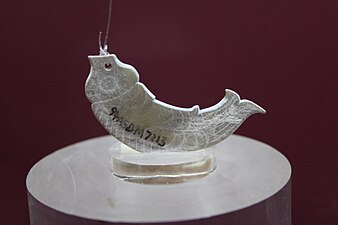
Shang jade pendant in the form of a fish

Jade pendants in the form of stags, Western Zhou.

Jade pendant with Huang, Western Zhou
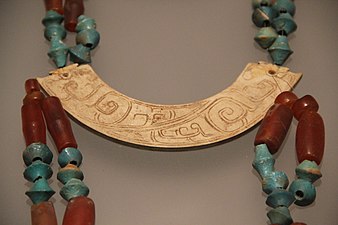
Western Zhou Jade Huang from a jade pendant.

Yupei from Ying state, Western Zhou
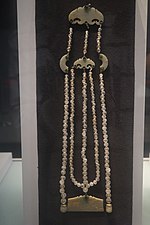
Yupei (玉佩), Tang Dynasty.

Ming Jade pendant
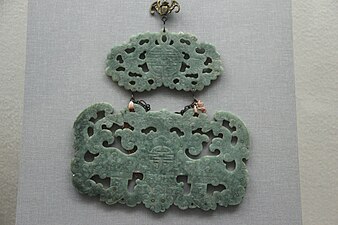
Jade pendant, Qing dynasty
Neck and shoulder accessories, and ribbons[]
| Name | Definition | Period | Images | ||
|---|---|---|---|---|---|
| Pizi | A cape; a wide and short cape which drapes over the shoulders.[5] | Northern dynasties - Tang dynasty. | 
|

|
|
| Pibo
(披帛) or peizi (帔子) |
A shawl,[16] or a long scarf;[17] it is longer and narrower than the pizi (cape) and it drapes on the shoulder from back to front.[5] | Tang - Unknown | 
|

|

|
| Xiapei (霞帔) | A woman's neckband which was trimmed with gold and lace.[18] In terms of design, it looked closer to a long scarf; it was worn in formal dress.[19] According to Ming's regulation, the Xiapei length had to be 5.7 chi and 0.32 chi width, with a suspended gold ornament at the end which purpose was to provide weight.[19] | Ming dynasty | 
|
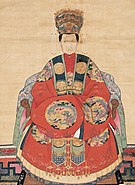
|

|
| A type of stole or tabard worn by women; it was developed from the xia pei worn in Ming dynasty. It was tied at the sides and reached below the knees. The bottom of the xia pei has a pointed hem. It was first worn by women on their wedding day, and later, they would wear on special occasions.[18][20] It is also decorated with colourful tassels at the bottom of the end.[19] | Qing dynasty | 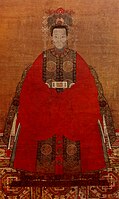
|

|
||
| Xian (襳) | Long ribbons which hung from the upper short skirt.[18] | Wei, Jin and Southern dynasties | 
|

|

|
| Yunjian (云肩) | "Cloud shoulder" or "cloud collar";[21][22] its name is derived from its shape when it is laid flat as it looks like a cloud.[19] It is a detachable collar worn on top of the jacket (and the xia pei in Qing dynasty).[21] It fell around the collar onto the chest and shoulders.[22] | Sui[23]-Qing | 
|

|

|
| Fangxing quling (方心曲領) | Lit. “bent collar with a square center”.[24] It is pendant-like accessory which falls on the overlapping front of a paofu.[24] It was a notable feature of ceremonial court attire during Song and Ming dynasties.[24] It is made of silk.[24] It consists a circle at the neck area and an open or solid square which hungs from the circle onto the chest area.[24] The fangxin quling contains the symbolism of Heaven (circle) and earth (square), respectively.[24] | Song - Ming[24] | 
|

|
|

|
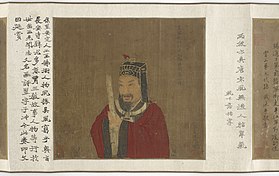
| ||||
Hand-held Fans[]
Historically, fans have played an important aspect in the life of the Chinese people.[25] The Chinese have used hand-held fans as a way to relief themselves during hot days since the ancient times; the fans are also an embodiment of the wisdom of Chinese culture and art.[26] They were also used for ceremonial purposes and as a sartorial accessory.[25]
So far, the earliest fans that had been found date to the Spring and Autumn and Warring States Period; these were made of either bamboo or feathers.[27] The arts of fan making eventually progressed to the point that by the Jin dynasty, fans could come in different shapes and could be made in different materials.[27]
Silk round-shaped fans (团扇; tuanshan), are also known as "fans of reunion", is a type of "rigid fan".[25][27] These types of fans were mostly used by women in the Tang dynasty and was later introduced into Japan.[28] These round fans remained mainstream even after the growing popularity of the folding fans.[29] Round fans with Chinese paintings and with calligraphy became very popular in the Song dynasty.[29]
In 988 AD, folding fans (折扇; zheshan) was first introduced in China by a Japanese monk from Japan as a tribute during the Northern Song dynasty; these folding fans became very fashionable in China by the Southern Song dynasty.[29] The folding fans later became very fashionable in the Ming dynasty.[25]
Another popular type of fan was the palmetto fan (蒲葵扇; pukui shan), also known as pushan (蒲扇), which was made of the leaves and stalks of pukui (i.e. Livistona chinensis).[28]
Replica of a Short-handled Bamboo Fan, Warring States period Tomb.

Female attendants of Emperor Taizong holding large oblong fans.
A girl holding a round fan with a long handle, Tang dynasty.
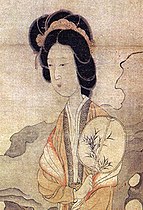
A woman holding a flat oval fan with a Chinese painting, a type of rigid fan; painting by Chen Hongshou (1598-1652).
A round fan with a Chinese painting, a type of rigid fan; late Qing dynasty.
A rigid fan with a Chinese painting of a cat and a calligraphy, late Qing dynasty.

Folding fan with a Chinese painting and a Chinese poem, painted by the Qianlong emperor, Qing dynasty, 1762 AD.

A pukui shan, a type of Chinese fan made with palm weaving.
early 1600s, view Fan
Hanfu makeup[]
| Name | Definition | Description | Period | Images | ||
|---|---|---|---|---|---|---|
| Huadian (花钿) | Also known as "Shouyang makeup" or "plum blossom makeup".[5] | A forehead decoration.[5] It was popular in Tang and Song.[5] | Southern dynasty - Tang dynasty | 
|
||
| An artificial red dimple about 1 cm at each side of the lips.[5] During High Tang, they evolved and some could be found at the 2 sides o the noses and be found in various shapes (e.g. coins, peaches, birds, and flowers).[5] | Tang - Five dynasties | |||||
| "Morning sun makeup" or "red slant" | It was originally called "morning sun makeup"; it is a red mark on both sides of the face to imitate Caopi's concubine, Xue Yelai's scar at the temple of her face.[5]
It was later called "red slant", and it was at put at the tip of each eyebrow.[5] |
Three Kingdom Period - Unknown | 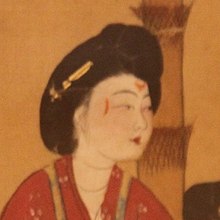
|
|||
| "Weeping makeup" or "tears makeup" | A short-lived fashion trend, when powder and rouge were not popular on the face; and the only makeup that was worn is black lipstick.[5] | Mid-Tang - Mid-Tang | ||||
| "mandarin duck".[5] | It is an eyebrow makeup. | Tang | ||||
| "Small peak".[5] | It is an eyebrow makeup. | Tang | ||||
| "drooping pearl".[5] | It is an eyebrow makeup. | Tang | ||||
| "dark fog".[5] | It is an eyebrow makeup. | Tang | ||||
See also[]
References[]
- ^ a b Rawski, Evelyn Sakakida (1998). The last emperors : a social history of Qing imperial institutions. Berkeley: University of California Press. p. 41. ISBN 0-520-21289-4. OCLC 37801358.
- ^ Walthall, Anne (2008). Servants of the dynasty : palace women in world history. Berkeley: University of California Press. pp. 143–144. ISBN 978-0-520-94151-9. OCLC 560506301.
- ^ a b c d e f Sheng, Angela (1995). "The Disappearance of Silk Weaves with Weft Effects in Early China". Chinese Science (12): 41–76. ISSN 0361-9001. JSTOR 43290485.
- ^ a b c d e f g Laursen, Sarah (2019). "10 Dressing the Dead in Jin China". The art and archaeology of bodily adornment : studies from Central and East Asian mortuary contexts. Sheri Lullo, Leslie V. Wallace. Abingdon, Oxon: Routledge. pp. 176–195. ISBN 978-1-351-26832-5. OCLC 1090702934.
- ^ a b c d e f g h i j k l m n o Hua, Mei (2004). Chinese Clothing (1 ed.). Beijing: China Intercontinental Press. ISBN 7-5085-0540-9. OCLC 60568032.
- ^ a b Baohai, Dang; 党寶海; Dang, Baohai (2003). "The Plait-line Robe. A Costume of Ancient Mongolia". Central Asiatic Journal. 47 (2): 198–216. ISSN 0008-9192. JSTOR 41917645.
- ^ Ho, Peng Yoke (2007). Explorations in Daoism : medicine and alchemy in literature. John P. C. Moffett, Cho Sungwu. London: Routledge. ISBN 978-0-203-96680-8. OCLC 127264736.
- ^ Zhu, Ruixi; 朱瑞熙 (2016). A social history of middle-period China : the Song, Liao, Western Xia and Jin dynasties. Bangwei Zhang, Fusheng Liu, Chongbang Cai, Zengyu Wang, Peter Ditmanson, Bang Qian Zhu (Updated ed.). Cambridge, United Kingdom: Cambridge University Press. p. 23. ISBN 978-1-107-16786-5. OCLC 953576345.
- ^ a b c Zang, Yingchun; 臧迎春. (2003). Zhongguo chuan tong fu shi. 李竹润., 王德华., 顾映晨. (Di 1 ban ed.). Beijing: Wu zhou chuan bo chu ban she. pp. 18–19. ISBN 7-5085-0279-5. OCLC 55895164.
- ^ Sax, Margaret; Meeks, Nigel D; Michaelson, Carol; Middleton, Andrew P (2004-10-01). "The identification of carving techniques on Chinese jade". Journal of Archaeological Science. 31 (10): 1413–1428. doi:10.1016/j.jas.2004.03.007. ISSN 0305-4403.
- ^ "Chinese jade". Encyclopedia Britannica. Retrieved 2021-03-20.
- ^ a b Yu, Ming (2011). Chinese jade. Cambridge, UK: Cambridge University Press. pp. 58–61, 67–69. ISBN 978-0-521-18684-1. OCLC 759918479.
- ^ Chinese sculpture. Angela Falco Howard. New Haven: Yale University Press. 2006. p. 49. ISBN 0-300-10065-5. OCLC 51631315.CS1 maint: others (link)
- ^ Guozhen, Wang (2019). Collection of Ancient Chinese Cultural Relics. Volume 1. Adelaide. pp. 49–54, 154–156, 158. ISBN 978-1-925371-29-1. OCLC 1175916450.
- ^ Clark, Carol (1998). Tropical gemstones. Singapore: Periplus Editions. p. 58. ISBN 978-1-4629-1664-1. OCLC 904404624.
- ^ Chen, Buyun (2019). Empire of style : silk and fashion in Tang China. Seattle. p. 84. ISBN 978-0-295-74531-2. OCLC 1101879641.
- ^ "Women Fashion of Tang Dynasty and Foreign Cultural Communication--《Journal of Zhejiang Wanli University》2008年01期". en.cnki.com.cn. Retrieved 2021-04-09.
- ^ a b c Lewandowski, Elizabeth J. (2011). The complete costume dictionary. Dan Lewandowski. Lanham, Maryland. p. 319. ISBN 978-0-8108-4004-1. OCLC 694238143.
- ^ a b c d Zhongguo xie zhen hua. Shanming Guan, 關善明 (Di 1 ban ed.). Xianggang: Mu wen tang mei shu chu ban she you xian gong si. 2003. pp. 38, 46. ISBN 988-97206-2-0. OCLC 56424659.CS1 maint: others (link)
- ^ Garrett, Valery M. (2007). Chinese dress : from the Qing Dynasty to the Present. Tokyo: Tuttle Pub. ISBN 978-0-8048-3663-0. OCLC 154701513.
- ^ a b Garrett, Valery (2012). Chinese Dress : From the Qing Dynasty to the Present. New York: Tuttle Pub. p. 184. ISBN 978-1-4629-0694-9. OCLC 794664023.
- ^ a b Shea, Eiren L. (2020-02-05). Mongol Court Dress, Identity Formation, and Global Exchange. Routledge. doi:10.4324/9780429340659. ISBN 978-0-429-34065-9.
- ^ Yang, Shaorong (2004). Traditional Chinese clothing : costumes, adornments & culture (1st ed.). San Francisco: Long River Press. ISBN 1-59265-019-8. OCLC 52775158.
- ^ a b c d e f g Burkus, Anne Gail (2010). Through a forest of chancellors : fugitive histories in Liu Yuan's Lingyan ge, an illustrated book from seventeenth-century Suzhou. Yuan, active Liu. Cambridge, Mass. p. 92. ISBN 978-1-68417-050-0. OCLC 956711877.
- ^ a b c d "Chinese Fans | Chinese Art Gallery | China Online Museum". www.chinaonlinemuseum.com. Retrieved 2021-03-28.
- ^ Qian, Gonglin (2004). Chinese fans : artistry and aesthetics (1st ed.). San Francisco: Long River Press. ISBN 1-59265-020-1. OCLC 52979000.
- ^ a b c Qian, Gonglin (2004). Chinese fans : artistry and aesthetics (1st ed.). San Francisco: Long River Press. pp. 3–4. ISBN 1-59265-020-1. OCLC 52979000.
- ^ a b "A Brief Introduction to Hanfu's Fans Culture - 2021". www.newhanfu.com. 2019-06-04. Retrieved 2021-03-28.
- ^ a b c Qian, Gonglin (2004). Chinese fans : artistry and aesthetics (1st ed.). San Francisco: Long River Press. pp. 8, 12–16. ISBN 1-59265-020-1. OCLC 52979000.
- Hanfu


















